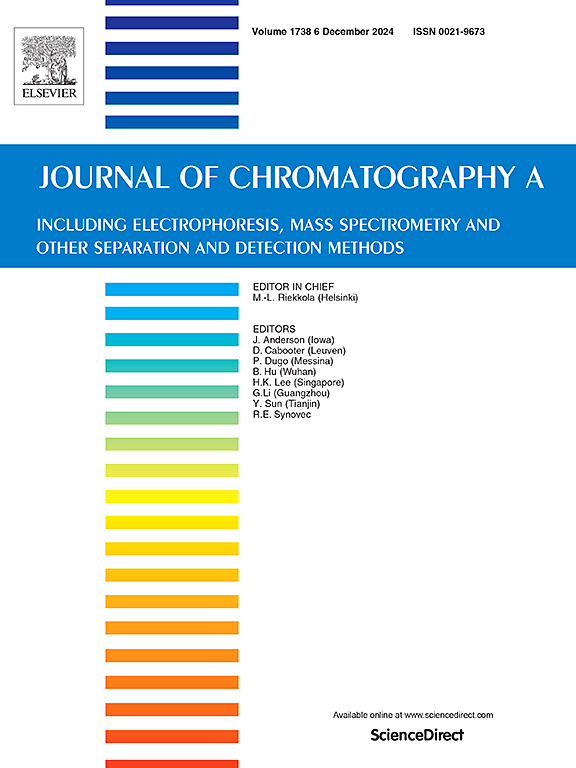超高效液相色谱-高分辨率质谱法同时手性分析人唾液中四种dl -硫醇化合物:吸烟者和非吸烟者氧化应激的差异评价
IF 3.8
2区 化学
Q1 BIOCHEMICAL RESEARCH METHODS
引用次数: 0
摘要
吸烟有害健康。然而,吸烟前后唾液中手性硫醇化合物作为体内氧化应激指标的动态变化潜力仍未得到探索。采用(R)-(5-(3-异硫氰酸atoprrolidin -1-yl)-5-氧戊基(NCS-OTPP)柱前衍生化方法,建立了一种高效液相色谱-高分辨率质谱(UHPLCHRMS)同时分离人唾液中4种dl -硫醇类化合物的方法。色谱柱为YMC Triart C18 (2.0 × 150 mm, 1.9µm), 0.1%甲酸水溶液和0.1%甲酸甲醇-乙腈(7:3,v/v),以65:35的比例等密度洗脱。dl -谷胱甘肽(GSH)、dl -半胱氨酸(Cys)、dl -同型半胱氨酸(Hcy)和γ-谷氨酰半胱氨酸(γ-Glu-Cys)的分离分离度为1.60-1.89,分离完全。在0.5 ~ 20µM范围内线性校准(R2≥0.9992),检出限为2.50 ~ 14.40 fmol。日内、日间精密度范围为0.33% ~ 9.64%,平均加标回收率为92.15 ~ 106.22%。该方法成功地测定了10名吸烟者和10名非吸烟者在不同时间点唾液中的4种dl -硫醇化合物。结果显示,吸烟者唾液中的dl -硫醇化合物浓度明显高于非吸烟者,其中l-GSH、DL-Cys和l-Hcy的浓度差异显著(p <;吸烟前后动态监测曲线与拟合曲线趋势一致。本研究介绍了一种监测唾液中dl -硫醇化合物动态变化的新方法,并提供了与体内异常手性硫醇代谢相关的潜在亚健康指标的见解。本文章由计算机程序翻译,如有差异,请以英文原文为准。
Simultaneous chiral analysis of four DL-thiol compounds in human saliva by Ultra-high-performance liquid chromatography high-resolution mass spectrometry: Differential evaluation of oxidative stress between smokers and non-smokers
Smoking is detrimental to health. However, the potential of dynamic changes in chiral thiol compounds in human saliva, both before and after smoking, as indicators of oxidative stress in vivo remains unexplored. A novel ultra-high-performance liquid chromatography high-resolution mass spectrometry (UHPLC![]() HRMS) method was developed for the simultaneous separation of four DL-thiol compounds in human saliva, utilizing a new (R)-(5-(3-isothiocyanatopyrrolidin-1-yl)-5-oxopentyl (NCS-OTPP) pre-column derivatization approach. Chromatographic separation was carried out using a YMC Triart C18 column (2.0 × 150 mm, 1.9 µm), with isocratic elution of 0.1 % formic acid aqueous solution and 0.1 % formic acid methanol-acetonitrile (7:3, v/v) at a ratio of 65:35. Separation of DL-glutathione (GSH), DL-cysteine (Cys), DL-homocysteine (Hcy), and γ-glutamylcysteine (γ-Glu-Cys) achieved resolution degrees of 1.60–1.89, with complete separation. Linear calibration was observed (R2 ≥ 0.9992) within a range of 0.5–20 µM, with detection limits spanning 2.50–14.40 fmol. The intraday and interday precisions ranged from 0.33 % to 9.64 %, while average spiked recoveries were 92.15–106.22 %. This method was successfully applied to assess the four DL-thiol compounds in the saliva of 10 smokers and 10 non-smokers at different time points. Results revealed significantly higher concentrations of the DL-thiol compounds in the saliva of smokers compared to non-smokers, with significant differences for l-GSH, DL-Cys, and l-Hcy (p < 0.05), returning to baseline levels within 15 min. Dynamic monitoring curves before and after smoking exhibited consistent trends with the fitted curves. This study introduces a new method for monitoring dynamic changes in DL-thiol compounds in saliva and offers insight into potential subhealth indicators linked to abnormal chiral thiol metabolism in vivo.
HRMS) method was developed for the simultaneous separation of four DL-thiol compounds in human saliva, utilizing a new (R)-(5-(3-isothiocyanatopyrrolidin-1-yl)-5-oxopentyl (NCS-OTPP) pre-column derivatization approach. Chromatographic separation was carried out using a YMC Triart C18 column (2.0 × 150 mm, 1.9 µm), with isocratic elution of 0.1 % formic acid aqueous solution and 0.1 % formic acid methanol-acetonitrile (7:3, v/v) at a ratio of 65:35. Separation of DL-glutathione (GSH), DL-cysteine (Cys), DL-homocysteine (Hcy), and γ-glutamylcysteine (γ-Glu-Cys) achieved resolution degrees of 1.60–1.89, with complete separation. Linear calibration was observed (R2 ≥ 0.9992) within a range of 0.5–20 µM, with detection limits spanning 2.50–14.40 fmol. The intraday and interday precisions ranged from 0.33 % to 9.64 %, while average spiked recoveries were 92.15–106.22 %. This method was successfully applied to assess the four DL-thiol compounds in the saliva of 10 smokers and 10 non-smokers at different time points. Results revealed significantly higher concentrations of the DL-thiol compounds in the saliva of smokers compared to non-smokers, with significant differences for l-GSH, DL-Cys, and l-Hcy (p < 0.05), returning to baseline levels within 15 min. Dynamic monitoring curves before and after smoking exhibited consistent trends with the fitted curves. This study introduces a new method for monitoring dynamic changes in DL-thiol compounds in saliva and offers insight into potential subhealth indicators linked to abnormal chiral thiol metabolism in vivo.
求助全文
通过发布文献求助,成功后即可免费获取论文全文。
去求助
来源期刊

Journal of Chromatography A
化学-分析化学
CiteScore
7.90
自引率
14.60%
发文量
742
审稿时长
45 days
期刊介绍:
The Journal of Chromatography A provides a forum for the publication of original research and critical reviews on all aspects of fundamental and applied separation science. The scope of the journal includes chromatography and related techniques, electromigration techniques (e.g. electrophoresis, electrochromatography), hyphenated and other multi-dimensional techniques, sample preparation, and detection methods such as mass spectrometry. Contributions consist mainly of research papers dealing with the theory of separation methods, instrumental developments and analytical and preparative applications of general interest.
 求助内容:
求助内容: 应助结果提醒方式:
应助结果提醒方式:


